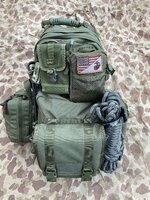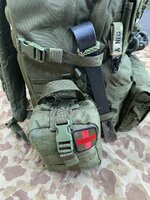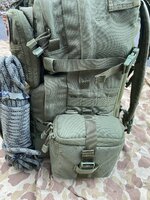- Messages
- 1,912
- Reactions
- 6,944
After the recent thread on get-home-bags, I thought a discussion on patrol packs might be both enjoyable and info.
Here is my current pack. It's a Condor medium with additional pouches attached; I've carried it for a couple of family trips to Disney World (configured differently) and its worked very well.
Weighs in at 27 pounds, two over my goal. I've incorporated a rip-away general purpose first aid kit on the left, binocular case on the right, 2 liter internal water bladder and large utility pouch on the center bottom that can hold eight AR magazines as needed.



The intent is for sustaining a 24 to 72 hour security patrol in a medium to long term grid down situation. I'm located in a suburb/rural interface and
Some additional items:
- Smallish tarp and tent stakes for shelter making
- Gortex rain jacket
- Work gloves, extra socks and thermal under shirt
- Weapon maintenance kit
- Clear and tinted safety glasses, dust mask, hearing protection
- Red and green surveying tape
- Maps, log book, pens, paint marker
- Pry bar and rope
- Utility kit with para cord, electrical tape, fire starter, zip ties, batteries, etc.
So, if any other NWFA members have a patrol pack or other emergency bag, please do share. Always interested in improving the knowledge base.
Here is my current pack. It's a Condor medium with additional pouches attached; I've carried it for a couple of family trips to Disney World (configured differently) and its worked very well.
Weighs in at 27 pounds, two over my goal. I've incorporated a rip-away general purpose first aid kit on the left, binocular case on the right, 2 liter internal water bladder and large utility pouch on the center bottom that can hold eight AR magazines as needed.



The intent is for sustaining a 24 to 72 hour security patrol in a medium to long term grid down situation. I'm located in a suburb/rural interface and
Some additional items:
- Smallish tarp and tent stakes for shelter making
- Gortex rain jacket
- Work gloves, extra socks and thermal under shirt
- Weapon maintenance kit
- Clear and tinted safety glasses, dust mask, hearing protection
- Red and green surveying tape
- Maps, log book, pens, paint marker
- Pry bar and rope
- Utility kit with para cord, electrical tape, fire starter, zip ties, batteries, etc.
So, if any other NWFA members have a patrol pack or other emergency bag, please do share. Always interested in improving the knowledge base.











